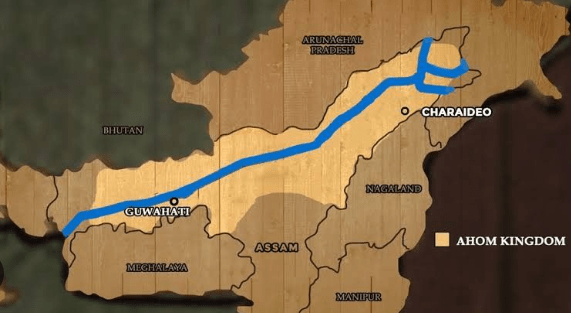- Courses
- GS Full Course 1 Year
- GS Full Course 2 Year
- GS Full Course 3 Year
- GS Full Course Till Selection
- Online Program
- GS Recorded Course
- NCERT (Recorded 500+ Hours)
- Polity Recorded Course
- Geography Recorded Course
- Economy Recorded Course
- AMAC Recorded Course
- Modern India, Post Independence & World History
- Environment Recoded Course
- Governance Recoded Course
- Science & Tech. Recoded Course
- International Relations and Internal Security Recorded Course
- Disaster Management Module Course
- Ethics Recoded Course
- Essay Recoded Course
- Current Affairs Recoded Course
- CSAT
- 5 LAYERED ARJUNA Mentorship
- Public Administration Optional
- ABOUT US
- OUR TOPPERS
- TEST SERIES
- FREE STUDY MATERIAL
- VIDEOS
- CONTACT US
Moidams Inscribed in the UNESCO World Heritage List
Moidams Inscribed in the UNESCO World Heritage List
26-08-2024
- In July 2024, during the 46th session of the World Heritage Committee (WHC) in New Delhi, the 700-year-old Moidams of Assam were officially inscribed on the UNESCO World Heritage List.
- The 46th session of the WHC, inaugurated by PM Narendra Modi, is being held in India for the first time.
- This marks a significant achievement as it is the 43rd Indian property to receive this honor and the first cultural site from the northeastern region to be included.
More in News
- The Moidams are the third World Heritage Property from Assam, joining the prestigious ranks of Kaziranga National Park and Manas Wildlife Sanctuary, both recognized in 1985 under the Natural category.
- This recognition underscores India's rich cultural heritage, with the country having successfully inscribed 13 World Heritage Properties in the last decade, now ranking 6th globally for the most World Heritage Properties.
About Moidams: The Mound-Burial System of the Ahom Dynasty
- Introduction: Moidams are royal mound burial sites created by the Tai-Ahom people in northeastern India. Situated in the foothills of the Patkai Ranges in eastern Assam, these burial mounds hold sacred significance for the Tai-Ahom and reflect their distinct funerary practices.
- The Tai-Ahom and Moidams: The Tai-Ahom clan migrated from China and established their capital in various parts of the Brahmaputra River Valley between the 12th and 18th centuries CE. Charaideo, their first city, also became the site of the royal necropolis. For 600 years, from the 13th to the 19th century CE, the Tai-Ahom constructed moidams, or "home-for-spirit," utilizing natural elements like hills, forests, and water to create a sacred geography.
- Construction and Features:
- Moiams are vaulted chambers (chow-chali), often double stories entered through an arched passage. The hemispherical mud-mound is topped with layers of bricks and earth, and its base is reinforced.
- Each vaulted chamber has a centrally raised platform where the body was laid, along with objects used by the deceased during their life, such as royal insignia, objects made of wood, ivory, or iron, gold pendants, ceramic ware, and weapons.
- The crematory ritduals of the Royal Ahoms were conducted with grandeur, reflecting their hierarchy.
- The Changrung Phukan (canonical text developed by the Ahoms) records the materials used to construct a Moidam, showcasing a variety in materials and systems of construction.
- From the 13th to the 17th century CE, wood was primarily used for construction. In the 18th century CE onwards, stone and burnt bricks of various sizes were used for the inner chambers.
- Boulders, broken stones, bricks, and broken brick were used to construct the superstructure, while large stone slabs were used for the sub-substructure.
- Significance: The Mound-Burial System of the Ahom Dynasty is an outstanding example of a Tai-Ahom necropolis, tangibly representing the Tai-Ahom funerary traditions and associated cosmologies.
About the Tai-Ahom Kingdom:
- The Ahom kingdom (1228–1826) was a late medieval kingdom in the Brahmaputra Valley (present-day Assam), established by Sukaphaa, a Tai prince from present-day Yunnan Province, China.
- The Ahom dynasty created a new state by overpowering the older political system of the bhuiyans (landlords) and expanded their influence, building a large state by the 16th century.
- The Ahom empire followed a monarchical system of governance.
- The kingdom weakened with the rise of the Moamoria rebellion and subsequently fell to repeated Burmese invasions of Assam.
- With the defeat of the Burmese after the First Anglo-Burmese War and the Treaty of Yandabo in 1826, control of the kingdom passed into East India Company hands.

Must Check: Best IAS Coaching In Delhi
UPSC Prelims Result 2024 Out: Expected Cut Off & Other Details, UPSC Prelims 2024 Answer with Explanation, Daily Prelims Quiz, Daily Current Affairs, MONTHLY CURRENT AFFAIRS TOTAL (CAT) MAGAZINE, Best IAS Coaching Institute in Karol Bagh, Best IAS Coaching Institute in Delhi, Daily Mains Question Answer Practice, ENSURE IAS UPSC Toppers, UPSC Toppers Marksheet, Previous Year Interview Questions, UPSC Syllabus




